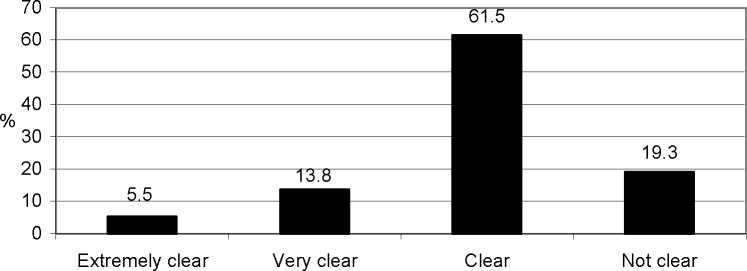Current Agriculture, Food & Resource Issues
D. Surprenant and J.-P. Gervais

Figure 5 Importers’ perceptions of the clarity of the administrtive import licensing
procedures of the current Canadian TRQ for chicken products.
import prices and domestic market conditions. Moreover, importers likely specialize in a
variety of products for which quality attributes result in different quota rents. Therefore, a
large variation should be expected in estimates of the TRQ rent. More than 29 percent of
importers estimate that the rent associated with current import restrictions in the Canadian
chicken industry is above $0.50/kg. Approximately one-quarter (24.1 percent) of
importers estimate the rent to be within the interval of $0.25/kg and $0.50/kg, while
11.1 percent and 9.3 percent of respondents estimate it to be within the intervals of
$0.10/kg to $0.25/kg and $0.01/kg to $0.10/kg, respectively.
It should be noted that more than one-quarter of the respondents declined to answer
the specific question dealing with rent estimates; this suggests that rent evaluation is a
delicate matter. Using publicly available data, Huff, Meilke and Amedei (2000) computed
the quota rents of Canadian chicken importers from 1995 to 1999. They found that the
average quota rents over the period were $0.52/kg. Focusing on the 1999 period yields a
lower import quota rent of $0.34/kg. These results are fairly well aligned with the
importers’ perceptions reported in the survey.
In the second stage of analysis, pairs of questions in the survey are analyzed to gain
further insights about the preferences of Canadian importers. Preferences towards
liberalization scenarios are grouped under two variables. The first category includes the
importers who reported supporting a more protectionist system than the one currently in
place or wishing to preserve the TRQ in its current form. The second category includes
importers wanting a more liberalized trading environment in the Canadian chicken
industry. Moreover, the various allocation methods are grouped based on the degree of
discretion they entail. The first group, termed non-discretionary methods, includes
licences allocated according to the first-come-first-served condition, licences allocated on
demand and licences auctioned. The second group includes licence allocation methods
70
More intriguing information
1. Labour Market Institutions and the Personal Distribution of Income in the OECD2. The mental map of Dutch entrepreneurs. Changes in the subjective rating of locations in the Netherlands, 1983-1993-2003
3. Examining the Regional Aspect of Foreign Direct Investment to Developing Countries
4. The name is absent
5. The name is absent
6. The name is absent
7. Output Effects of Agri-environmental Programs of the EU
8. The Macroeconomic Determinants of Volatility in Precious Metals Markets
9. Spatial agglomeration and business groups: new evidence from Italian industrial districts
10. Novelty and Reinforcement Learning in the Value System of Developmental Robots